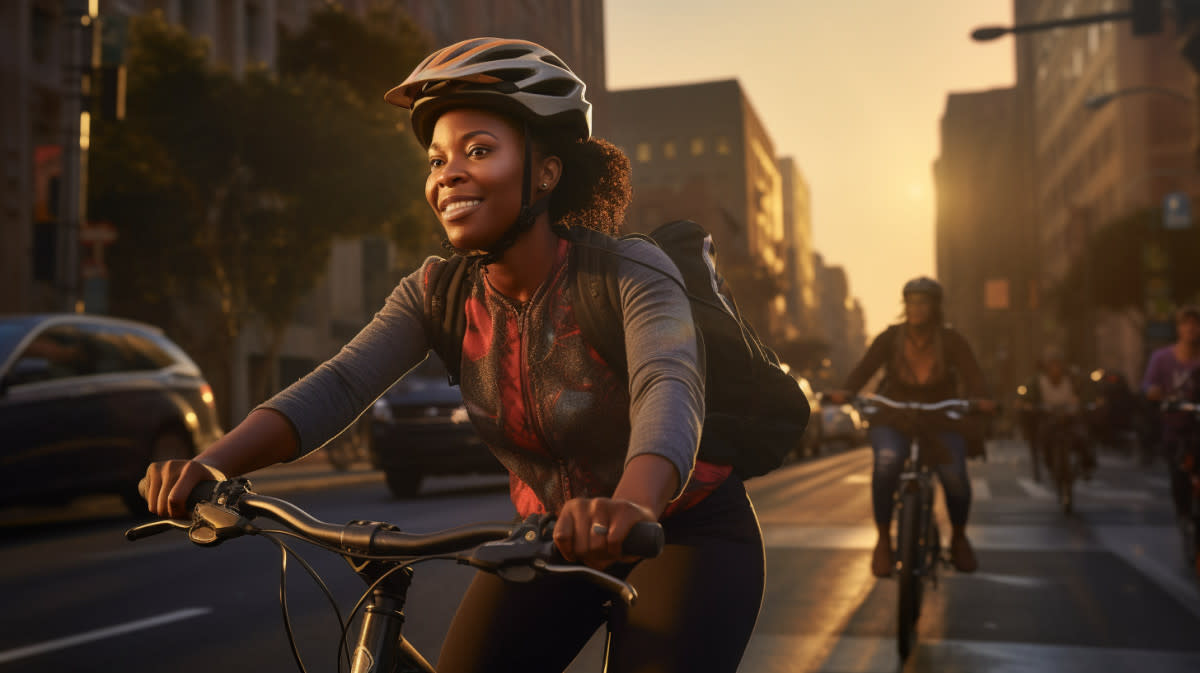New California Law Helps Make Changes to Cycling Infrastructure

Bruno Long/MidJourney
As the number of cyclists and e-bikes continues to grow throughout the United States, the people who champion better and safer infrastructure for cyclists need to do their best to mitigate some of the problems that arise naturally with more people sharing the roadways.
Both drivers and cyclists alike need to be more diligent than ever with road safety, knowing the rules of the road and paying more attention to traffic while on the streets. Yet we all know that distractions are plenty when it comes to driving in the car (navigation, incoming texts, phone calls, screaming kids in the back who want to stop for ice cream), they are also present in many cyclists who aren't sure how they should act when in the flow of traffic.
Oftentimes, cyclists blur the line between acting like a vehicle and behaving like a pedestrian. As bikers, many times we decide to be a pedestrian or a vehicle when it suits our needs best. We often merely slow down at an intersection before plowing through when there is no traffic. Or merely slow down at a red light or stop sign, only to keep moving if traffic allows for it. Many times we neither signal nor shoulder check when making turns as we come into intersections or in the flow of traffic.
Dangerous Intersections
Intersections are where the highest number of cyclist and pedestrian accidents are. To help reduce the number of accidents at intersections, an initiative was created in the late 2000's called Leading Pedestrian Interval (LPI), which allows pedestrians a head start on the right-of-way before traffic is allowed to commence.
A study about the effects of LPI in 2008 found that there was an almost 60% reduction in traffic and pedestrian accidents in areas where LPI was integrated. In 2016, a San Francisco high-traffic intersection that also introduced the LPI technology saw a reduction to zero accidents over 8 months after seeing 13 accidents in the same area over 5 years.
New Bill Takes Effect
A recently approved bill, called California Bill A.B. 1909, now permits cyclists in the state to get a small headstart (same as pedestrians) of anywhere from three to seven seconds before the light turns green for motor vehicles. Giving cyclists and pedestrians a slight head start gives them more visibility to motor vehicles and often a chance to clear the intersections before the motor vehicle traffic is given the green light, greatly reducing the chances of an accident occurring.
In effect, at these intersections, cyclists and pedestrians have the same rights. While this doesn't exactly designate cyclists as 'pedestrians', it is part of a broader understanding of what cyclists and e-bikers are becoming as technology changes. Infrastructure changes are already becoming a large problem as e-bike technology and the number of cyclists grows at a much faster rate than city, state or government legislation can be ratified to adjust to the needs of cyclists.
In terms of costs associated with this type of infrastructure change, they are relatively cheap and simple compared to what some cities and communities would need to spend on improving bike lanes, etc. The traffic lights are already in place and the main adjustment would be the reprogramming of the traffic lights, which comes out to somewhere between $200-$1200.
Related: 10 Safety Tips for E-bike Commuters
More Unique Infrastructure
In Bellingham, Washington, a major cycling community in the PNW, has also taken a unique approach to making intersections a safer place for cyclists. Their community plan around cycling infrastructure has been implemented for years but can still help inspire other communities in terms of ideas that they can bring up to their next city plan meeting.
These designated 'bike boxes', allow cyclists up to the front of an intersection where they can get a head start making motor vehicles more aware of the bikes and giving everyone a chance to get out of the way before cars go. Giving cyclists a place to wait out a red light, in clear view of other vehicle traffic, increases the visibility of the rider, making left and right turns at intersections much safer.
The large green boxes also give motor vehicles a very visible indicator that bicycle traffic is important, thereby increasing their awareness that bicycles or e-bikes may be present in the area. this should in turn make them more careful when going through an intersection or checking their mirrors before making any right-handed turns into another lane.
More Infrastructure Needed
While these initiatives and bills are a great sign of improving infrastructure, there is still a greater need for improvements throughout the country. If you feel the need for better cycling infrastructure in your community, do what you can to help that message get across to local legislators. Write letters or emails, start a fundraiser or join your local government to help bring more awareness to this important subject. Safety is key to growing the micromobility movement and there is a need for more advocates to raise awareness and reduce the amount of accidents and fatalities due to motor vehicle and cycling incidents.

